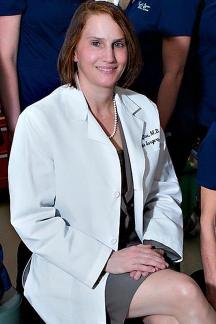Loftus Plastic Surgery Center
Natural Results from a National Expert
Right Here In Cincinnati and Northern KentuckySchedule a
Consultation
513-793-4000
859-426-5000
Breast Implant Revision
Redo of Breast Augmentation Surgery
Women who have breast implants should be aware that at some point they may be likely to require an additional operation for one or more reasons. This page will address many of those possibilities.
The overall rate for requiring revision surgery in the United States is 25%. This means that 25% of women who have breast implants will have an additional operation on her breast implants within the first five years of having those implants.
At Loftus Plastic Surgery Center, our rate of revision is substantially lower, being around 3% within the first five years. There are many reasons why our revision rate is lower than the national average, and the details for why our rate is so low is explained on the many pages on this site related to implant complications and risks. But for the purpose of this page, we will address the various reasons why women seek revision surgery and how that revision surgery might be performed.
Capsular Contracture or Pain
Capsular contracture is a scar that forms around the breast implant and which subsequently tightens down around the implant, causing it to feel hard and even hurt. Whereas the scar itself is normal, the contraction of the scar causing the implant to feel hard is not. Possible reasons for the cause of capsular contracture and reducing the rate can be found here. The treatment for capsular contracture involves at the very least: removal of the implant, surgical removal of the scar, and placement of a new implant. If the capsular contracture is recurrent, such that it has previously been treated only to come back, then an additional measure would be to also move the implant to the position below the muscle. If the implant is below the muscle already, the implant could be moved to above the muscle. Although this overall has a higher risk of capsular contracture. Another option is removal of the implant, and leaving the implant out for six months to a year to allow the tissues to heal. Re-introducing an implant after this timeframe may result in a lower rate of the capsular contracture recurring. An additional maneuver for prevention of recurrence of the capsular contracture is to remove the implant and the scar tissue as one unit. This is called Enbloc. This is the procedure that Dr. Loftus recommends most often because, in her hands, the capsular contracture has never recurred when performing this type of capsulectomy. The only disadvantage of this type of capsulectomy, is that it requires a longer incision. There are a number of additional measures which can be instituted to reduce the likelihood of the capsule recurring, and these are explained here. A final option for addressing capsular contracture is to simply do nothing. This is actually a very reasonable approach for women with a very mild capsular contraction, provided that it is not bothering the woman, and that she feels that surgery would be a greater problem than living with the existing capsular contracture.Rippling and Wrinkling
Rippling and wrinkling are far more common with saline implants than with silicone, and are more likely to occur when the implants are placed over the muscle than under. They're also more likely to occur in women with nominal breast tissue. If rippling and wrinkling occur, the best solution is to switch the implant to an Ideal Saline implant or a silicone implant, provided that the original implant is standard saline. If the implants are placed above the muscle and the rippling in the upper and medial sides, then the remedy for this is to move the implant to below the muscle. If however you are a woman with silicone implants under the muscle who still has wrinkling due to very thin breast tissue, there is not a whole lot that can be done with the exception of switching to a more highly cohesive breast implant such as the Gummy Bear implants. Unfortunately, Gummy Bear implants come with their own set of disadvantages, and those are explained here.Malposition
Implant malposition means that the implants have moved out of their optimal location. They can obviously move in any one of four directions, and the direction that they move dictates the procedure which is necessary to move them back into place.Implants which are malpositioned upward can be moved downward through downward displacement exercises. If downward displacement exercises fail to bring the implants down after several months, it is reasonable to operate on the breast to move the implants down, and this can be done under sedation.
If the implants have moved too far medially, they can be moved laterally. However, the bigger question arises as to why the implants moved medially in the first place. Often times, when the implants move medially on their own it is because the patient has a depression in the middle of the rib cage (called the sternum). If that is the case, then moving the implants laterally will most likely only be a temporary fix, as the implants will have a tendency to want to migrate medially over time. This can be a difficult problem to fix, however performing a procedure such as a capsulorrhaphy will increase the likelihood of success. This is the same procedure which is performed to correct a condition called symmastia.
If the implants are too low, then the capsulorrhaphy can be performed to raise them, and this is a fairly common procedure. The problem with a capsulorrhaphy is that the original implant malposition can recur if the capsulorrhaphy is not performed correctly. Even if it is performed correctly, the capsulorrhaphy can result in asymmetry and divots along the crease beneath the breast.
If the implants haved move too far laterally, in the direction of the armpit, then moving them more medially is an option using a capsulorrhaphy. The same issues apply here with regard to a capsulorrhaphy, in that the condition could recur.
By now, you're getting the sense that implant malposition can be a difficult problem, and indeed this is true. If you have this problem and want your implants moved, you really are best off seeing a plastic surgeon who is very comfortable with each of these operations and who has a very low rate of having to revise implant redos down the road.
Asymmetry
Nearly all breasts start asymmetrically and end up asymmetrically following breast augmentation surgery. This is simply the nature of human anatomy, and this is not a problem. The problem occurs when the asymmetry is more than the norm, or is worse after surgery than it was prior to surgery. Most often, asymmetry following breast augmentation is related to implant malposition, and that is discussed in the above paragraph. Asymmetry may also be related to breast volume asymmetry and nipple asymmetry. If this is the case, then a breast lift may be advised to restore symmetry to the breast.Rupture or Deflation
Rupture of silicone implants and deflation of saline implants are known to occur in 1 to 3% of implants every year. Saline deflations are immediately evident, and the treatment for this is to replace the implant. Silicone ruptures may or may not be evident, and that is explained here. In either case, the treatment is removal of the implant and placement of a new implant. Patients frequently ask Dr. Loftus whether or not the unaffected implant should also be replaced, and her response is that if it's not broken, should not be fixed. That is, unless the patient also seeks a change in size of the implant or type of implant at the time that the rupture or deflation is replaced. In those cases, then both implants should logically be replaced. But aside from those cases, replacing the normal implant is unnecessary surgery. If a patient truly wants the opposite implant replaced, then it is reasonable to perform it; however, Dr. Loftus prefers to reassure patients that choosing to not replace the normal implant is a very reasonable and appropriate thing to do, and that the normal implant seldom has problems in the near term.Change in Size
Desire for change in size of implants nationally is ranges from 10 to 20% of patients. In Dr. Loftus's practice, the number is less than 1%. If you were seeking revision surgery to have your size changed, you really need to spend a significant amount of quality time with your plastic surgeon (or a new plastic surgeon) to be certain that you get the size that you desire, the second time around. Suggestions for determining implant size can be found here.Desire for Removal
Some women simply want their implants removed. Dr. Loftus tends to see this in women who have had their implants in place for decades. If they are saline implants, removal is generally simple and can be done under local anesthesia. If they are silicone implants, which have been in place for more than a few decades, they are most likely the old style type of silicone implants that have a very thin shell. As a result of the shell being so thin, the shell sometimes merges with the scar tissue over the course of the decades that it has been in place. As a result, the implant cannot simply be removed without taking out the scar tissue, and this is a capsulectomy. So, the length of time your implants have been in and the type of implant will determine the ease of the implant removal.Other
As with anything, there are also other reasons why women might want their implants removed or revised. Each of these cases needs to be evaluated on their own. Dr. Loftus sees the patients of other plastic surgeons who seek implant revision on a regular basis, and she feels that each case is different and each case deserves it's own special considerations.If you have implants and seek revision surgery for any of the above mentioned reasons or a different reason, it is ideal for you to obtain your original operative note and bring that with you to your consultation with Dr. Loftus. If your surgery was performed so many years ago that the operative note cannot be located, Dr. Loftus is still very happy to see you, evaluate you, and treat you. Dr. Loftus frequently has to evaluate patients with no prior operative report available. This is slightly more challenging, but she is very comfortable doing this and has done it quite often.
Age: 32 "After" Photos Taken: 2 months post op
| Before | After |
| Before | After |

About Dr. Loftus
Dr. Loftus is a female plastic surgeon who is considered a national authority on plastic surgery, having appeared on numerous talk shows as an expert. Her book has become a best-selling book on plastic surgery and has earned her the reputation as a vocal advocate of patient safety, satisfaction, and education in plastic surgery. No wonder her patients have such great things to say about her…

| My results are amazing - Dr. Loftus is amazing! |
Reviews on Loftus Plastic Surgery Center
TV Appearances of Dr. Loftus
Cincinnati: The Christ Hospital2139 Auburn Avenue, Suite 201
Cincinnati, OH 45219
(513) 793-4000
View Map
Cincinnati, OH 45219
(513) 793-4000
5 minutes from downtown Cincinnati,
At the Christ Medical Office Building
At the Christ Medical Office Building
View Map
Northern Kentucky1881 Dixie Highway, Suite 300
Fort Wright, KY 41011
859-426-5000
View Map
Fort Wright, KY 41011
859-426-5000
3 minutes from downtown Cincinnati &
visible from I-71/75
visible from I-71/75
View Map






